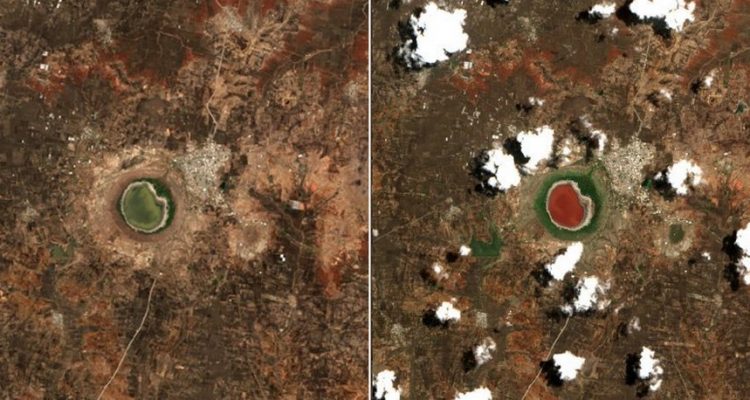A crater lake in the western state of Maharashtra, India, turned pink overnight, delighting fans around the world and intriguing specialists who attributed this change to changing salinity levels and presence of algae in the water.
The Lonar crater lake formed some 50,000 years after a meteorite crashed on Earth. It is located 500 kilometres from Mumbai, and about 100 kilometres from the famous Ajantâ caverns. This crater is the largest crater dug in basalt rocks. Partially filled by a saltwater lake, it is a site known to tourists and environmentalists. Almost circular in shape, the crater has a diameter of 1.83 kilometres and is 170 meters deep.
It is interesting to note that the very first research was directed towards a volcanic origin of the crater. However, it has now been identified as an impact crater: this origin of impact is clearly demonstrated by the presence of plagioclase which was converted into maskelynite, a transformation which could only be done by the shock of an impacting meteorite.
Now, while photos showing the new colours of the lake’s waters are starting to circulate on social networks, experts have said that, although Lonar Lake has already changed colour in the past, the transformation certainly never had was also blatant.
Since the past four days or so, #Maharashtra's world-famous #LonarLake – the world's third biggest formed by a meteorite hit – has mysteriously changed colour from its normal bluish-green to a baby-pink shade.
(IANS) pic.twitter.com/kzGnpccnYf
— The Weather Channel India (@weatherindia) June 11, 2020
” The salinity in the lake has increased as the water level has dropped dramatically this year and it has also warmed, causing an algae bloom, ” said geologist Gajanan Kharat in a published video by the state-owned Maharashtra Tourism Development Corporation, on Twitter. ” This alga becomes reddish at warmer temperatures and the lake, therefore, turned pink overnight, ” said Kharat.
Forest department officials collected water samples to determine the exact cause of the change.
As businesses, factories and offices have been closed for months, due to the containment which only started to ease this week, blue skies are returning to many of India’s highly polluted cities, also sparking speculation, according to which the restrictions could also have had an impact on the lake.
Lonar Lake, the lake inside the Lonar Impact Crater in India, has recently turned red due to a micro-organism bloom:https://t.co/4dzCOkgRKS
Here are two @CopernicusEU #Sentinel images, one from this morning (r) and one from a year ago (l), showing the dramatic colour change: pic.twitter.com/xqY55kZpL6— Dr Marco Langbroek (@Marco_Langbroek) June 11, 2020
” There has not been much human activity due to the confinement, which could also have accelerated the change, ” said Madan Suryavashi, head of the geography department at Babasaheb Ambedkar University in Maharashtra. ” But we will not know the exact causes until our scientific analysis is completed in a few days, ” he said.













